Conn 12A Coprion

Date: 1940, Owned by Robert McCall
Notice the coprion bell. The 12A is the cornet equivalent of the 12B Coprion trumpet. This is probably one of the nicest 12A's around. It is certainly one of the best preserved 12A I have ever seen on eBay or anywhere else. The lacquer is original and in very good condition. On instruments with a Coprion bell it is always easy to see if the lacquer is original or not: If the lacquer is original, the Coprion will have a color like the bell in this 12A pictured here, varying between a deep honey color and dark red. Relacquered Coprion becomes almost pink.
I have learned that the third slide, without the finger ring to adjust the pitch of a low D and C#, is slightly longer than it is on modern instruments. On modern instruments the low Eb is in tune, but the low D and C# are quite sharp. On these older cornets with the longer third slide and no finger ring the Eb is a bit flat and the D and C# are slightly sharp, but not as sharp as they are on later instruments. It was thought that the slightly flat Eb and slightly sharp D and C# were within the abilities of the player to lip into tune.
The bore size is #2 (0.468"); Conn called this a "medium" bore. It is my experience that the bore sizes for "small", "medium" and "large" bores are half a step higher for cornets compared to trumpets. So a trumpet "medium" would be a #1½ while a cornet medium is usually a #2.
One 12A owner describes his 12A like this: "All notes, either low or high, are very clear. Lower notes have a nice deep clear sound. At a medium pitch it produces a beautiful sound. You could definitely be heard if you played this baby loudly. High notes are crisp and clear. It really projects. Truly a great playing instrument. I would definitely say it projects more than any of my other instruments. It can produce a lot of sound and still maintain its tonality. Definitely one of my top players. It plays so easily and produces such a great sound. It is truly a fanctistic cornet. Much better than a 1950 Olds Recording Cornet that I had. It rivals my 1940 Silver plated Conn Concert Grand, which plays equally as well, but perhaps just a little less bright."
The person who took the above picture described this 12A as "[Using a short shank Conn 3 mouthpiece], the horn gets a nice mellow, sweet sound in the middle register, and really projects in the upper register. A great playing horn."
The 12A pictured here isn't only in great original condition, it also includes all the original booklets, guarantee card and Conn's at the time top of the line "Skyline" case, easily recognizable by the brown leather on the outside and dark red plush on the inside. The owner, Robert McCall is the original owner of this instrument. Apparently he played for a few years in the early 1940's, but very little after WW2. Hence the immaculate condition with all the original equipment.
The 12A was produced from at least 1939 (production start date possibly 1938) to 1955. The description from the 1955 catalog (below) lists the instrument as being 2 lbs. 14 oz. I suspect this is considerably heavier than earlier versions of the 12A, since in the 1930's and 1940's instruments generally weren't made to be that heavy, and in 1955 Conn added quite a bit of weight to many of its instruments. Also, the 1955 catalog shows a 12A with the word "Coprion" engraved on the leadpipe. This was common from 1954-1955 onwards, but not before that date. Perhaps this is another indication that the 1955 12A was a bit different from the earlier models.
As far as I can tell at this point, all Conn cornets built before 1955 take a short shank cornet mouthpiece as opposed to the 2¾" "Bach-style" long shank cornet mouthpiece. The long shank cornet mouthpieces will fit a pre-1955 Conn cornet, but won't give the proper intonation or playing characteristics of a short shank cornet mouthpiece. All of Conn's "Connstellation" cornet mouthpieces are long shank mouthpieces. The "standard" (my term) Conn mouthpieces such as the Conn 4 are long shank if there is a "ridge" halfway down the shank, and short shank if there is no ridge. Also, the long shank mouthpieces have "Conn" and the number of the mouthpiece stamped across the mouthpiece, whereas the short shank mouthpieces have it stamped along the length of the mouthpiece. All Conn cornet mouthpieces built before the "standard" series, such as the "Wonder" and "AI-412" are short shank mouthpieces.
What Conn said in 1939:
New wide model, designed to take fullest advantage of the revolutionary Coprion bell. Here is the greatest cornet tone
you ever listened to. Accuracy of intonation and ease of response will also amaze you. Comfortable hand hold, perfect
balance. Patented Clickless Crysteel valves. Medium bore, Bb and A. Brass, heavily lacquered.
What Conn said in 1955:
This is the shortest, widest cornet in the entire Conn line... and it features the famous seamless COPRION bell
which provides such exceptional power and ease of blowing. Amazing flexibility, most accurate scale. Sensational medium bore,
large tone. Has the popular "Clickless Crysteel" bottom spring valves - another exclusive Conn feature that good cornet players
appreciate because the action is so fast, so smooth. Built in Bb and A. Length 16 1/2", weight 2 lbs. 14 oz., bell diameter
4 5/8". In handsome two-tone tan and rawhide vinyl covered case, beautifully plush lined with mouthpiece and music lyre.
Highly polished brass, nickel trim, Coprion bell, clear lacquer.